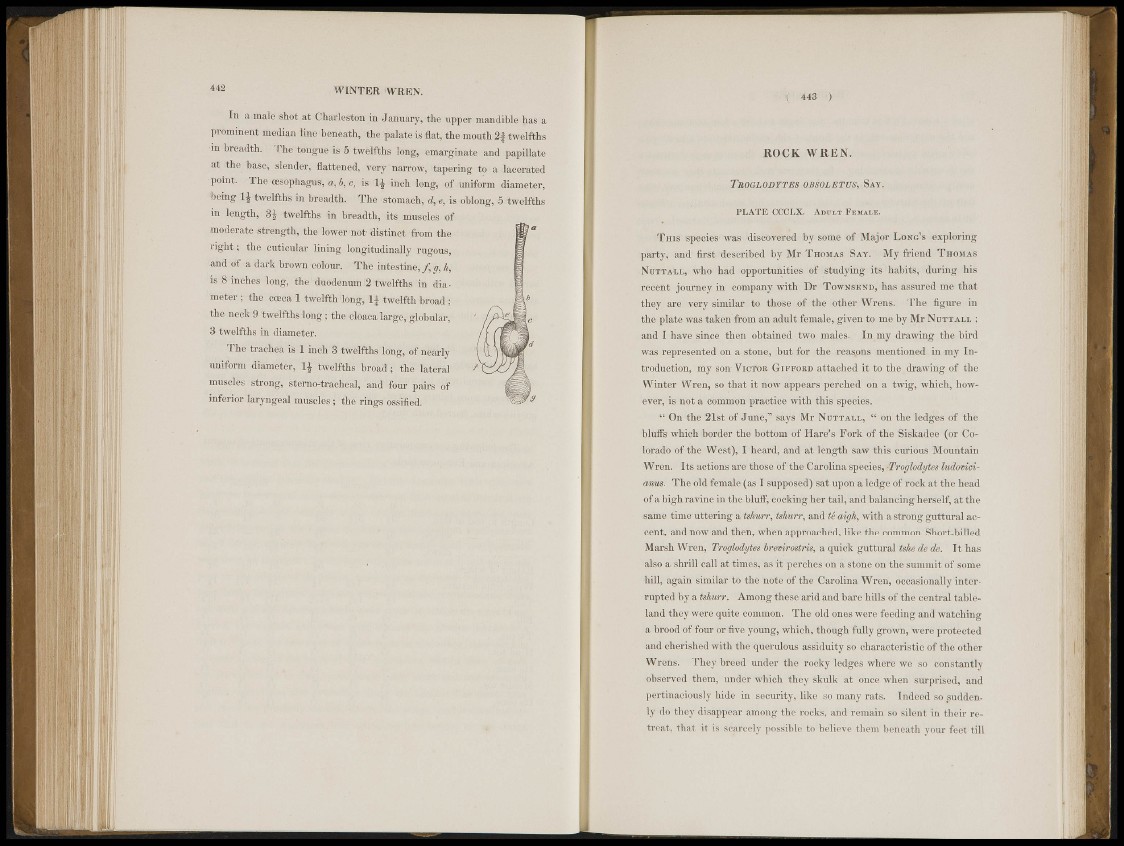
442 WINTER "WREN.
In a.male shot at Charleston in January, the upper mandible has a
prominent median line beneath, th.- palate is Hat, the mouth 2f twelfths
m breadth. Th.. tongue is fi twelfths long, emarginate and papilla*
at till. base,, sl.mder, flattened, vory narrow, tapering to a (lacerated
I'"i"t- The oesophagus, a. inch long, of uniform diameter,
«being twelfths in breadth. The • stomach, is oblong, 5 ¡twelfths
in length, if I twelfths in breadth, its muscles of
moderate streti^th, the lowormot- distinct • from the W °
right; the eutie.ular lining longitudinally rugous,
anil of a .lark brown eolmir. Tlri< intestine,/¿/.li, S
is 18 taches long, the a<iodenSam:2 twelfths, in dia- - H
meter: the ettwa'l twelfth ;long,-1 { tw.ilfth broad ; Jf e
the meds; 9' twelfths-long ; the idloacâ large, .globular, ' /AkJjjL
3 twelfths iai' diameter. •• '•. i ¡ ¿ v . g-/f (WMm
The trachea is 1 inch 3 twelfths Iring, of-nearly ' ; LyffÉljf*
uniform diameter, 1J twelfths ftroàât thé later»
muscles strong, sternu-tracheal, and'tmir j igl *èf ':|1 V1'' : • • B g j f l
inferior laryngeal muscles; the rings ossified. '• "" ^F*
ROCK WREN.
TROGLODYTES OBSOLETUS, Say.
PLATE CCCIJC. AI>I:I.T Kkmai.»:.
This species was discovered by Some of Major Loss's exploring
party. and first: described by Mr Thomas Say. My friend Thomas
Nhttam,, who had opportunities of studying its habits;- during his
recent journey in company with Dr Townsend, has assured me that
they are vory similar to those of the other Wrens. The figure in
the plate was taken from an adult female, given to me by Mr Nut t a l i . ;
and I have since theni-obtained two males. In my drawing the bird
was represented on a stone, but for the reasons mentioned in my Introduction,
my son Victor Gifford attached it to tbe.drawing of the
Winter Wren, so that it now appears perched on a twig, which, however,
is not a common practice with this species.
" On the 21.*t of June,"' says Mr Nut t a l l , " on the ledges of the
bluffs which border the bottom (if Hare's Fort of the Siskadee (or Colorado
'of the West), I heard, and at length saw this curious Mountain
Wren. Its actions are those of the Carolina species, -Troglodytes ludovieianus.
Tht old female (as I supposed) sat upon a ledge of rock at the head
of a high ravine in the bluff, cocking her tail, and balancing herself, at the
same time'uttering a tskwn\ tshwrr, and Ut aigh, with a strong guttural accent,
and now and then, when approached, like the common Short-billed
Marsh Wren, Troglodytes brevirostris, a quick guttural tshedede. It "has
also a shrill call at times, as it perches on a stone on the summit Of some
hill, again similar to the note of the Carolina Wren, occasionally interrupted
by a tshurr. Among these arid and bare hills of the central tableland
they were quite common. The old ones were feeding and watching
a brood of four or five yoking, which, though fully grown, were protected
and cherished with the querulous assiduity So characteristic of the other
Wrens. 'They breed under the rocky ledges where we so constantly
observed them, under which they skulk at once when surprised, and
pertinaciously hide in ¡security, like so many rats. Indeed so suddenly
do they disappear among the rocks, and remain so silent in their retreat,
that it is scarcely possible to believe them beneath your feet till